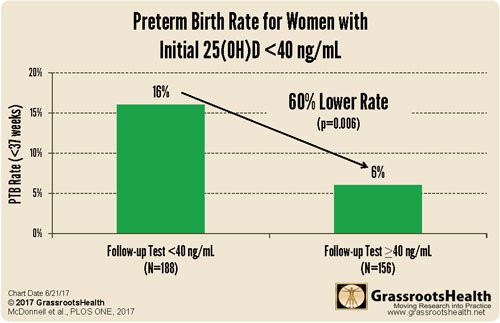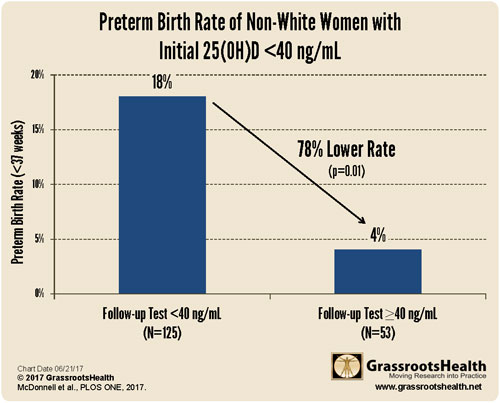Dark Days: It’s Time To Test Your Vitamin D Levels

The optimal Vitamin D level for health and disease prevention is between 60 and 80 ng/mL.
Depression susceptibility: below nanograms per milliliter (ng/mL) may increase your risk by as much as 85 percent, compared to having a vitamin D level greater than 30 ng/mL.
Type 2 Diabetes risk: people with a median level of 41 ng/mL present a diabetes rate of 3.7 per 1,000. Those with a median serum level of 22 ng/mL have a diabetes rate of 9.3 per 1,000.
Pre-term birth risk: up to 59% of preterm birth (which represents 28% of newborn deaths during the first 30 days of life) could be prevented by optimizing the pregnant woman’s vitamin D level to 40 ng/mL.
Breast cancer risk: levels above 60 ng/mL can lower risk by 83% compared to women with levels below 20 nl/mL
There are various ways to test your Vitamin D levels. Some of our favorites are at-home prick tests such as those provided by Vitamin D Council and Grassroots Health. Both tests are around $60 and include personalized lab reports.
There are numerous health issues that Vitamin D can play a supporting role in preventing or reducing symptoms, such as autoimmune diseases, gastrointestinal disease, dry eyes, rheumatoid arthritis, obesity, bone injuries, neurological disorders, dental health and much more.
High-Dose Vitamin D Increase the Need for Calcium, Magnesium and K2
Something of note also is the interplay between vitamin D, calcium, magnesium and Vitamin K2. While it’s important to supplement with quality vitamin D3 to optimize your levels, you may also need to increase key minerals and vitamin K2 so that all are working properly in your body.
When these four key nutrients are imbalanced, there may be symptoms of vitamin D toxicity or increased risk of heart attack and stroke. The latter is most often caused by taking calcium supplements when vitamin K2 levels are low, which then causes overabsorption of calcium. This then in turn may cause calcium deposits in your heart and kidneys.
A proper calcium to magnesium ratio is important, since magnesium keeps calcium in cells so they can function better. The historical healthy calcium-magnesium ratio has been 1-to-1.
Magnesium and vitamin K2 also complement each other, as magnesium helps lower blood pressure, which is an important component of heart disease.
Thus, when you supplement with any of the following: magnesium, calcium, vitamin D3 or vitamin D2, remember to take all the others into consideration as well.
(Statistics from Dr. Mercola article and various studies).
Vitamin D Levels During Pregnancy Must Be Considered for Healthy Babies
Protect Our Children NOW! is a GrassrootsHealth campaign launched in 2015 to combat vitamin D deficiency among pregnant women worldwide.
Research conducted through this project reveals up to 59 percent of preterm births — which are responsible for 28 percent of newborn deaths during the first month of life — could be prevented simply by raising pregnant women’s vitamin D to a level of 40 ng/mL.
Preterm babies are also more likely to suffer health problems later on, including a higher risk of ADHD, cerebral palsy, autism, asthma,22,23 intestinal problems, pneumonia, vision problems, hearing loss and dental problems.24,25,26 Your vitamin D status during pregnancy can even influence your child’s future risk for cardiovascular disease.27,28
As of 2015, the U.S. had a preterm birth rate of 9.6 percent, meaning nearly 1 in 10 babies were born prematurely. The U.S., while one of the most advanced countries in the world, ranked No. 130 in preterm births out of 184 countries in 2010.
Protect our Children NOW! is a cost-effective, reproducible program that protects children by ensuring pregnant mothers are vitamin D sufficient, and could go a long way toward improving these abysmal statistics. Among non-Caucasian women (among whom vitamin D deficiency is more common and prominent) the reduction in risk was even greater.
In this group, the preterm rate prior to the start of the study was 18 percent. Those who achieved a vitamin D level of 40 ng/mL by their second test had a 78 percent lower preterm birth rate — reducing the preterm birth rate to just 4 percent!


Aside from halving the risk for preterm birth, vitamin D optimization also protects the mother by reducing her risk of preeclampsia, gestational diabetes and prenatal infections by approximately 50 percent.29 If you are currently 12 to 17 weeks pregnant, you can join the join the GrassrootsHealth pregnancy study for free and test your vitamin D level from the comfort of your own home.
If you are planning a pregnancy, or are more than 17 weeks pregnant, you can take control of your and your child’s health by using the D*Action test kit. It’s one of the most cost-effective ways to monitor your vitamin D status.
So, now it the time to get tested and to optimize your levels for a healthier winter and year ahead!
Photo by Mira Kemppainen on Unsplash






